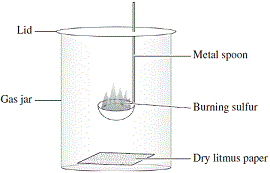Footnotes
1 We will consider only the "normal" oxides. Apart from the normal oxide, Na2O, sodium also forms an ionic peroxide, Na2O2.
However, it should be noted that when Na combusts, Na2O will also react with O2 to produce Na2O2, so the major product of the combustion of sodium is Na2O2.
2 Limiting the supply of oxygen during combustion produces the lower oxide, P4O6 instead of P5O10
3 When phosphorus burns in excess oxygen, phosphoric oxide, P4O10, is produced.
4 When sulfur combusts, sulfur dioxide, SO2(g), is produced.
The oxidation of SO2 to SO3 by oxygen is spontaneous, but very slow:
SO2(g) + ½O2(g) → SO3(l)
5Several of the oxides of chlorine are prone to explode: ClO2, Cl2O, Cl2O3 and Cl2O7.
These appear to be shock sensitive rather than thermally sensitive.
Even so, ClO2 and Cl2O are both used commercially as bleaching agents, particular for bleaching paper and flour.
Commercially, ClO2 is prepared by the exothermic reaction between sodium chlorate in about 4 mol L-1 H2SO4 containing 0.05-0.25 mol L-1 chloride ion with sulfur dioxide:
2NaClO3 + SO2 + H2SO4 → 2ClO2 + 2NaHSO4
Cl2O can be prepared by treating freshly prepared yellow mercuric oxide with chlorine gas or with a solution of chlorine in carbon tetrachloride:
2Cl2 + 2HgO → HgCl2.HgO + Cl2O
6 There is only one formula for the oxide of aluminium, Al2O3, known as alumina, however, a number of polymorphs and hydrated species exist.
There are 2 forms of anhydrous Al2O3 known as α-Al2O3 and γ-Al2O3.
α-Al2O3 is very hard and resistant to hydration and attack by acids.
γ-Al2O3 is softer, readily takes up water and dissolves in acids.
There are several hydrated forms of alumina including AlO.OH and Al(OH)3, but these are prepared in alkaline solutions, not by reacting alumina with water.
7 This reaction occurs in cold water. If hot water is used, a range of products are formed such as PH3, phosphoric acid and element P.
8 This reaction occurs readily, making P4O10 a good drying agent, but it does produce a mixture of acids, depending on the quantity of water and other conditions.
9 There is no doubt that gaseous SO2 dissolves in water, but the acid, H2SO3 hasn't been isolated. Nevertheless, this equation is commonly accepted as a representation of the reaction.
10 Carbon dioxide, CO2, is an acidic oxide, but carbon monoxide, CO, is a neutral oxide.
11 Nitrogen dioxide, NO2, is an acidic oxide, but nitric oxide, NO, and nitrous oxide, N2O, are neutral oxides.

